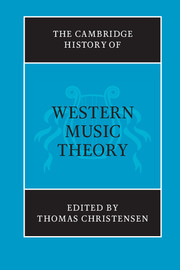Book contents
- Frontmatter
- Introduction
- PART I DISCIPLINING MUSIC THEORY
- PART II SPECULATIVE TRADITIONS
- PART III REGULATIVE TRADITIONS
- A Mapping tonal spaces
- B Compositional Theory
- 15 Organum – discantus – contrapunctus in the Middle Ages
- 16 Counterpoint pedagogy in the Renaissance
- 17 Performance theory
- 18 Steps to Parnassus: contrapuntal theory in 1725 precursors and successors
- 19 Twelve-tone theory
- C Time
- D Tonality
- PART IV DESCRIPTIVE TRADITIONS
- Index of authors
- Index of subjects
- References
15 - Organum – discantus – contrapunctus in the Middle Ages
from B - Compositional Theory
Published online by Cambridge University Press: 28 March 2008
- Frontmatter
- Introduction
- PART I DISCIPLINING MUSIC THEORY
- PART II SPECULATIVE TRADITIONS
- PART III REGULATIVE TRADITIONS
- A Mapping tonal spaces
- B Compositional Theory
- 15 Organum – discantus – contrapunctus in the Middle Ages
- 16 Counterpoint pedagogy in the Renaissance
- 17 Performance theory
- 18 Steps to Parnassus: contrapuntal theory in 1725 precursors and successors
- 19 Twelve-tone theory
- C Time
- D Tonality
- PART IV DESCRIPTIVE TRADITIONS
- Index of authors
- Index of subjects
- References
Summary
“Anyone who aspires to understand contrapunctus should write down the following matters.” So begins a short manual on counterpoint from the early fourteenth century that circulated widely under the authority of Jehan des Murs but is best identified (anonymously) by its incipit “Quilibet affectans.” The theorist’s remarks are straightforward indeed. Contrapunctus observes a strictly note-against-note texture. Only select intervals – some perfect in nature (unisons, fifths, octaves), others imperfect (minor third, major third, and major sixth) – are admitted between the voices, as are their octave compounds. The natural sequel to any authorized interval is that interval from the opposite category closest in size: minor third (imperfect) after unison (perfect); octave (perfect) after major sixth (imperfect). Although characterized as “natural,” these contiguous progressions are by no means mandatory. The motion of the cantus, the pre-existent melody to which another line is joined in counterpoint, may well prompt other intervallic successions. Within the latitude this affords, no perfect interval may be reiterated in direct succession, but any imperfect interval may be followed by another, or by several, of the same kind. Aside from such parallels, the two voices ought usually to proceed in contrary directions, so that when the cantus ascends, the new line descends, and vice versa. All contrapunctus must begin and end with perfect consonance.
The compact array of precepts set forth in “Quilibet affectans” hardly seems to qualify as theory. It reads as a set of rudimentary guidelines for production of correct note-against-note polyphony in two parts. Yet the opening declaration that the path to understanding contrapunctus is to write these rules (rather than, say, to sing or to compose model progressions or phrases) does appear to claim some theoretical status for what follows (as does one stray reference to Boethius).
- Type
- Chapter
- Information
- The Cambridge History of Western Music Theory , pp. 477 - 502Publisher: Cambridge University PressPrint publication year: 2002
References
- 10
- Cited by

